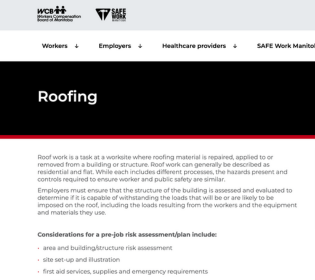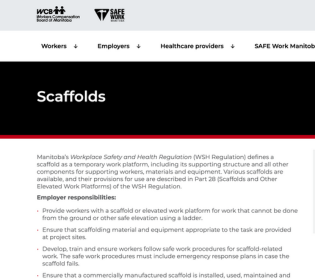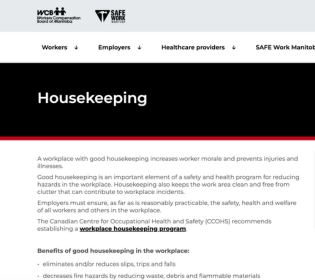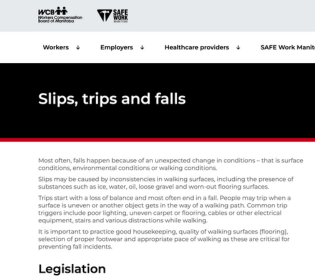Slips, trips and falls
Slips, trips and falls can have a lifetime impact.
Slips, trips and falls are the second leading cause of serious workplace injuries in Saskatchewan. Take safer steps to protect yourself and others.

Slips, trips and falls can have a lifetime impact.
Slips, trips and falls are the second leading cause of serious workplace injuries in Saskatchewan. Take safer steps to protect yourself and others.

You might not expect to be seriously injured in a slip, trip or fall. In fact, they can cause serious injuries that might last a lifetime. Get the facts on the impacts of slips, trips and falls. The information below is based on WCB Saskatchewan data from 2018 to 2021.
You might not expect to be seriously injured in a slip, trip or fall. In fact, they can cause serious injuries that might last a lifetime. Get the facts on the impacts of slips, trips and falls. The information below is based on WCB Saskatchewan data from 2018 to 2021.
There are simple steps you can take to prevent slips, trips and falls. Learn the differences between them, how to identify risks and how to prevent injuries.
Select a category:
What are slips?
Slips happen when you don’t have enough traction or friction between your shoes and the surfaces you are working on. They are often caused by slippery surfaces, such as ice, water, oil, loose gravel or worn-out flooring.
Slips can cause sprains, fractures, strains, cuts and bruises to your back, ankle, arms, legs and head.
How to prevent slips
There are some easy things you can do in any situation to prevent slips:
- Don’t rush – take your time.
- Always pay attention to your work setting. Check your surroundings, even for regular everyday activities.
- Practice good housekeeping.
Each of the hazards below can cause a slip. Click or tap on the hazard to see how to prevent an injury.

Frost, ice, black ice or snow
Have good lighting. Do outdoor work during the day. Use a flashlight when entering dark areas.
Waxed floors
Take shorter strides and have feet pointing slightly outwards to improve balance.
Spills of any kind, including food or water
Clean all spills immediately.
Wetness – such as mud
Wear proper-fitting footwear that is appropriate for the work you are doing.
Smooth, cold surfaces (metal stairs)
Keep one hand free to balance or break a fall.
Loose items such as gravel, debris, mats
If mats are necessary, use pressure-sensitive adhesive to keep them from moving.
Smooth-painted floors
Paint smooth floors with sand set in the mixture.
A trip can happen when your foot or a body part hits something and it causes you to lose your balance. Trips start with a loss of balance and most often end in a fall. You can trip on uneven surfaces or objects that are in the way of a walking path.
Trips can lead to bruises, cuts, sprains and fractures to your feet, ankles, back, arms or head.
There are some easy things you can do in any situation to prevent trips:
- Always pay attention to your work setting.
- Check your surroundings, even if it is a regular everyday activity.
- Do not rush – take your time.
- If you are carrying or pushing anything, make sure you can see clearly in all directions. Ensure items you carry do not obstruct your view.
- Practice good housekeeping.
Each of the hazards below can cause a trip. Click on the hazard to learn how to prevent an injury.

Uneven stairs, walkways, or doorways
Use handrails when using stairs. On flat walkways, keep one hand free to balance or break a fall.
Wrinkled carpets or mats
It mats are necessary, use pressure-sensitive adhesive to keep them from wrinkling.
Snow or frozen ice ruts
Make sure you are wearing proper footwear when working outside.
Poor lighting
Have good lighting. Do outdoor work during the day. Use a flashlight when entering dark areas.
Open cabinet drawers
Always close filing cabinets or storage drawers when you’re not using them.
Cables or cords
Cover cables and cords that cross walkways.
Materials on the floor (wood, tubing, clothing, books, buckets)
Remove obstacles and clutter from walkways.
About 60 per cent of slips and trips end in a fall. Falling even a short height can cause a serious injury – in fact, the leading cause of serious injuries from slips, trips and falls is falls to a floor, walkway or other surface. The height you fall and the surface you land on can increase the seriousness of the injury.
Each of the hazards below can cause a fall. Click on the hazard to learn how to prevent an injury.

Coming down from equipment or from a platform to the ground
Use your hands to provide three-point contact when getting and out of vehicles, equipment or climbing ladders. When working above 1.2 metres, wear a safety harness or personal protective equipment (PPE).
Stepping into an unmarked hole
Check your worksite for any potential hazards. Take your time and pay attention to your surroundings. Make sure you have proper lighting.
Using an unbalanced ladder or makeshift ladder extension
Always use a ladder or step ladder to reach high shelves (never stand on a chair or box).
Leaning off a ladder or platform causing it to become unbalanced
Make sure your ladders, platforms or other equipment are in safe working condition. Wear a harness while on the ladder.
Slipping off the side or edge of worksite
Use guardrails or warning devices for open sides, edges and openings. Wear a harness when applicable.
When working at heights, use fall protection
When working at any height above 1.2 metres, you should have fall protection.
There are three types of protection:
- Fall prevention: A barrier that prevents workers from falling off the edge of the work platform, such as a guardrail or safety net.
- Travel restraint: A tie-off system that prevents workers from getting too close to a fall hazard. The system usually includes a harness connected to a lanyard tied off at a set length from a weighted tie-off point.
- Fall arrest: A system that stops workers in mid-fall before they can hit a surface that would cause injury. The system usually includes a harness, anchorage support, lifeline and lanyard. Lifelines should be at least 16 mm in diameter and made of strong materials (polypropylene or other strong materials are recommended over nylon, which stretches more).
The type of fall protection used depends on the job being performed. Talk to your supervisor to find out what equipment is best to keep you safe.
Inspect and maintain fall protection equipment regularly
Inspecting fall protection gear frequently is as important as using it. Fall protection systems are only effective if they are used properly, which includes keeping them in good working condition.
Use the following checklists to inspect your fall arrest or travel restraint equipment every day.
Harness
- Make sure hardware and straps are intact and not worn, with no twists or tears in the fabric.
- Ensure all moving parts are moving freely.
- Check webbing to make sure it’s free of burns, cuts, loose or broken stitching, frayed material, and signs of heat or chemical damage.
Lanyard with shock absorber
- Inspect entire rope length to ensure there are no worn, broken or cut fibres.
- Make sure the lanyard attaches securely to the D-ring on the harness
- Check hardware for rust, cracks or damage.
- Check shock-absorbing lanyards regularly: look for any significant tears, wears or burns – discard any lanyards that show damage.
Lifeline
- Test retractable lifelines for smooth and proper retraction.
- Inspect lifeline fibres and look for wears, tears, cuts or burns.
- Check for deterioration caused by prolonged sun or chemical exposure.
- Ensure all other fall protection equipment (including D-rings, buckles, snaphooks, webbing, anchorage, rope grabs and shock absorbers), are inspected regularly for wear, tear and cracks. Replace any parts that show signs of damage.
- Always use shock absorbers with fall protective gear.
- Have all protective equipment inspected at least once a year (depending on use) by a certified inspector.
To maintain your fall protection equipment:
- Replace any worn or broken equipment.
- Replace any equipment previously involved in a fall.
Ladders are used at work for many different tasks. They are best for light-duty tasks that can be completed in 15 minutes or less and for accessing a work area such as a roof, mezzanine or scaffolding. Working at heights – including on a ladder – always involves the risk of falling. Read, download and share the ladder safety tips below to help you and your co-workers prevent a fall from a ladder.

Set-up and inspection
Ladders are used at work for many different tasks. They are best for light-duty tasks that can be completed in 15 minutes or less and for accessing a work area such as a roof, mezzanine or scaffolding. Working at heights – including on a ladder – always involves the risk of falling. Read, download and share the ladder safety tips below to help you and your co-workers prevent a fall from a ladder.

Set-up and inspection
Ladders are used at work for many different tasks. They are best for light-duty tasks that can be completed in 15 minutes or less and for accessing a work area such as a roof, mezzanine or scaffolding. Working at heights – including on a ladder – always involves the risk of falling. Read, download and share the ladder safety tips below to help you and your co-workers prevent a fall from a ladder.












 Slips, trips and falls can have a lifetime impact: Office
Slips, trips and falls can have a lifetime impact: Office Slips, trips and falls can have a lifetime impact: Construction
Slips, trips and falls can have a lifetime impact: Construction Slips, trips and falls can have a lifetime impact: Courier
Slips, trips and falls can have a lifetime impact: Courier Slips, trips and falls can have a lifetime impact: Hardware
Slips, trips and falls can have a lifetime impact: Hardware OHS answers: Prevention of slips, trips and falls (CCOHS)
OHS answers: Prevention of slips, trips and falls (CCOHS) Preventing slips, trips and falls (Workplace Safety Prevention Services)
Preventing slips, trips and falls (Workplace Safety Prevention Services) Roofing (SAFE Work Manitoba)
Roofing (SAFE Work Manitoba) Scaffolds (SAFE Work Manitoba)
Scaffolds (SAFE Work Manitoba) Housekeeping (SAFE Work Manitoba)
Housekeeping (SAFE Work Manitoba) Slips, trips and falls (SAFE Work Manitoba)
Slips, trips and falls (SAFE Work Manitoba) Fall protection measures among residential construction companies (Report, PDF 320 KB)This report provides insights into the barriers to using fall protection in residential construction workplaces in Saskatchewan. It is based on focus groups and one-on-one interviews with supervisors and workers in smaller residential construction companies and stakeholders in the construction industry.
Fall protection measures among residential construction companies (Report, PDF 320 KB)This report provides insights into the barriers to using fall protection in residential construction workplaces in Saskatchewan. It is based on focus groups and one-on-one interviews with supervisors and workers in smaller residential construction companies and stakeholders in the construction industry. Fall protection use and Saskatchewan construction workers (Infographic, PDF 350 KB)This is a two-page graphic summary of the fall protection research report.
Fall protection use and Saskatchewan construction workers (Infographic, PDF 350 KB)This is a two-page graphic summary of the fall protection research report. Preventing falls from heights (Video)Watch Dr. Lynda Robson’s presentation of her research into the effectiveness of training standards for preventing fall-from-height injuries.
Preventing falls from heights (Video)Watch Dr. Lynda Robson’s presentation of her research into the effectiveness of training standards for preventing fall-from-height injuries.








